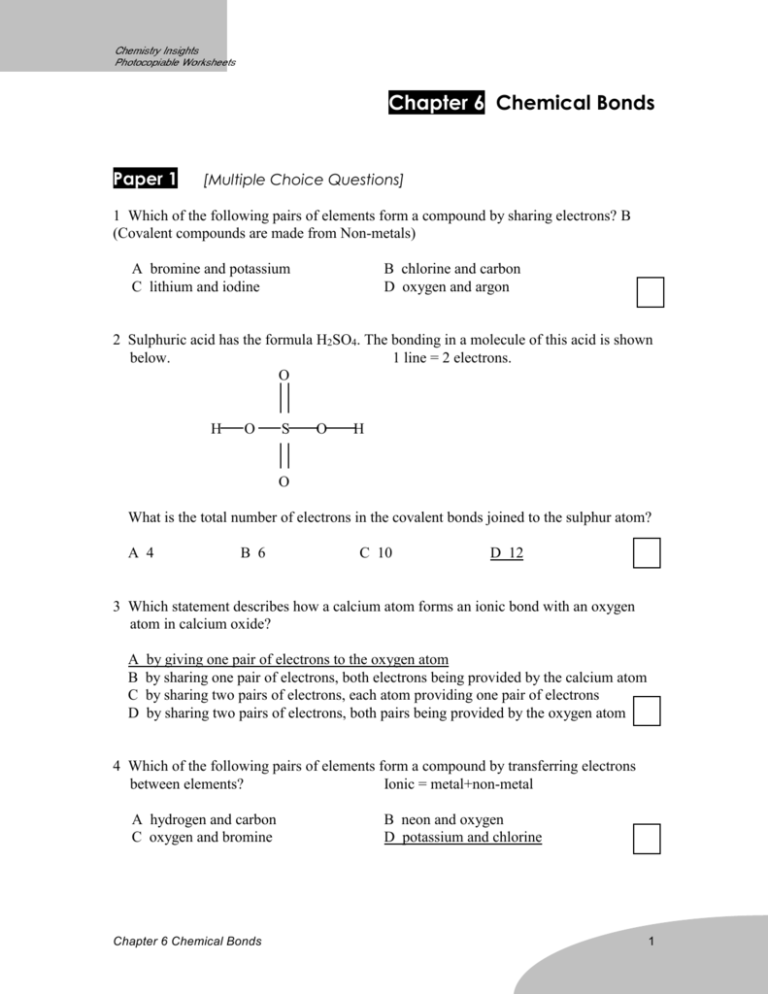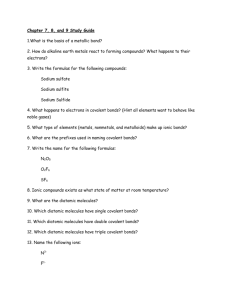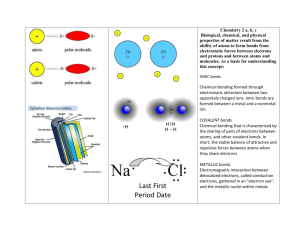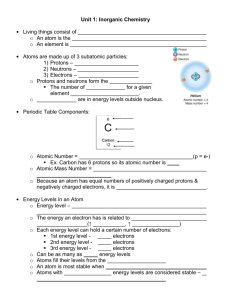Chapter 6 Chemical Bonds
advertisement

Chapter 6 Chemical Bonds Paper 1 [Multiple Choice Questions] 1 Which of the following pairs of elements form a compound by sharing electrons? B (Covalent compounds are made from Non-metals) A bromine and potassium C lithium and iodine B chlorine and carbon D oxygen and argon 2 Sulphuric acid has the formula H2SO4. The bonding in a molecule of this acid is shown below. 1 line = 2 electrons. O H O S O H O What is the total number of electrons in the covalent bonds joined to the sulphur atom? A 4 B 6 C 10 D 12 3 Which statement describes how a calcium atom forms an ionic bond with an oxygen atom in calcium oxide? A B C D by giving one pair of electrons to the oxygen atom by sharing one pair of electrons, both electrons being provided by the calcium atom by sharing two pairs of electrons, each atom providing one pair of electrons by sharing two pairs of electrons, both pairs being provided by the oxygen atom 4 Which of the following pairs of elements form a compound by transferring electrons between elements? Ionic = metal+non-metal A hydrogen and carbon C oxygen and bromine Chapter 6 Chemical Bonds B neon and oxygen D potassium and chlorine 1 5 Which compound has both covalent and ionic bonds? A ammonia C ethanoic acid B ammonium sulphate D sodium chloride 6 Element X has an electronic structure 2,8,8,1. Element Y has an electronic structure 2,8,6. What is the likely product of the reaction between X and Y? X+ with Y2A a covalent compound of formula XY2 B a covalent compound of formula X2Y C an ionic compound of formula X2Y D an ionic compound of formula XY2 7 The structures of four molecules are drawn below. I II III IV What are the correct names for each molecule? A B C D I carbon dioxide carbon dioxide methane methane II water oxygen carbon dioxide water III methane water water carbon dioxide D IV oxygen methane oxygen oxygen 8 Which solid does not contain covalent bonds? metal D A diamond B ice C methane D zinc 9 The diagram shows the electronic structure (outer shells only) of a molecule of compound XY2. What could be elements X and Y? Chapter 6 Chemical Bonds 2 X Y Y (Y has 7 electrons and X has 6 elctrons in the outemost shells.) A C sulphur and oxygen oxygen and hydrogen B D chlorine and sulphur neon and oxygen 10 Which one of the following is an element consisting of small molecules? A chlorine C ice (covalent) B copper D magnesium 11 The atomic structures of four particles are given in the table. particle P Q -1 ion R +1 ion S number of protons 17 17 19 19 number of neutrons 18 20 19 20 number of electrons 17 18 18 19 Which two particles have joined together to form an ionic compound? A P and Q B Q and R C R and S D S and P 12 An element Z has proton number 4. Which statement about Z is correct? A It forms ions by gaining electrons. B It is a very poor conductor of electricity. C Its oxide contains ionic bonds. D It forms a compound with chlorine with the formula ZCl4. Paper 2 [Structured Questions] 1 (a) The diagram shows all the electrons in a molecule. Chapter 6 Chemical Bonds 3 key: p = proton = electron 8p = electron 6p (i) State the name of this molecule. 8p Carbon dioxide ......................................................................................................................... (ii) State the type of bonding present in this molecule. Covalent [2] (b) Draw a similar diagram to show all the electrons in a molecule of water, H2O. H O H 2 The element fluorine (proton number = 9) can form either covalent of ionic bonds. (a) Predict, with a reason, the type of bonding you would expect to find in (i) aluminium fluoride, AlF3 type of bonding: .........ionic............................................................................... reason: made from a metal Al and non-metal F (ii) hydrogen fluoride, HF Chapter 6 Chemical Bonds 4 type of bonding: covalent reason: made from non-metals H and F .[4] (b) Draw ‘dot and cross’ diagrams to show the bonding in the following substances, showing all the electrons in the atoms. (i) fluorine, F2 F F (i) sodium fluoride, NaF - + sodium ion, Na+ fluoride ion, F[4] (c) Explain why the melting point of sodium fluoride is much higher than that of fluorine (F2). Chapter 6 Chemical Bonds 5 NaF is an ionic compound consisting of strong ionic bonds while F2 consists of weak intermolecular forces. [1] 3 The diagram below shows the arrangement of electrons in the outer shell of an atom of element E. (a) State the Group in the Periodic Table to which E belongs. VII [1] (b) E forms an ion. Give the formula of the ion formed by E. E[1] (c) E forms a compound with carbon. Draw a ‘dot and cross’ diagram to show the bonding you would expect in this compound, showing only the outer shell electrons. Cl Cl C Cl Cl [2] Chapter 6 Chemical Bonds 6 4 Hydrogen iodide has melting point -51oC and a boiling point of -35oC. (a) In what state is hydrogen iodide at room temperature and pressure? Gas [1] (b) Iodine is in Group VII of the Periodic Table. Use this fact to (i) predict the type of bonds in hydrogen iodide. Covalent (ii) predict the formula of hydrogen iodide. HF (iii) construct a ‘dot and cross’ diagram to show the bonding in hydrogen iodide, showing only the outer shell electrons. H F [4] 5 Nitrogen forms the covalent molecule ammonia, NH3. The structural formula of ammonia is shown below. H H N H (a) Give the type of and number of bonds formed by nitrogen in ammonia. Covalent, 3 (b) Nitrogen forms the same type of and number of bonds in hydrazine, N2H4. (i) Construct the structural formula of hydrazine. Chapter 6 Chemical Bonds 7 H- N – N - H | | H H (ii) What is the empirical formula of hydrazine? NH2 [3] Chapter 6 Chemical Bonds 8







